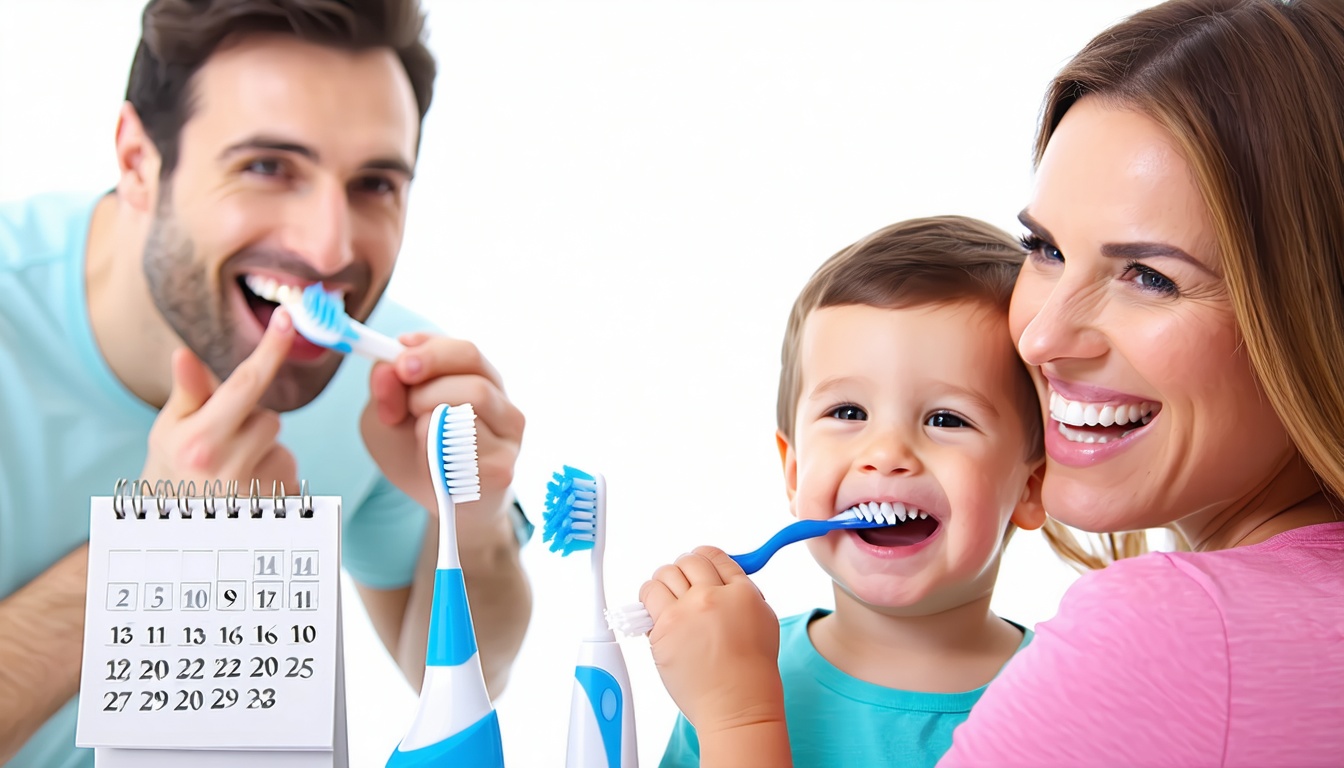Importance of Changing Toothbrushes
Taking care of our oral health includes not only brushing regularly but also ensuring our toothbrushes are effective. Understanding the importance of changing our toothbrushes helps maintain optimal dental hygiene.
Regular Replacement Benefits
Regularly replacing our toothbrushes offers numerous benefits for our oral health. A worn toothbrush is less effective at removing plaque and food particles, which can lead to cavities and gum disease. According to Healthline, we should replace our toothbrushes every three to four months. This timeline helps ensure that our toothbrush remains effective.
Benefits of regularly changing our toothbrushes include:
| Benefit | Description |
|---|---|
| Improved Cleaning | A new toothbrush has bristles that clean teeth more effectively. |
| Reduced Bacterial Growth | Old toothbrushes can harbor bacteria, which may contribute to oral infections. |
| Enhanced Gum Health | Using a fresh toothbrush can prevent issues such as gingivitis. |
| Better Overall Oral Care | Consistent replacements promote better oral hygiene habits. |
Signs of Toothbrush Wear
Being able to identify signs of toothbrush wear is essential in knowing when to replace it. We should be observant of the following indicators:
- Frayed Bristles: When the bristles start to splay or lose their original shape, they can no longer clean effectively. This type of wear indicates it’s time for a new toothbrush.
- Discoloration: If the bristles change color or show signs of wear, it may diminish the effectiveness of the toothbrush.
- Unpleasant Odor: A toothbrush that develops a bad smell should be replaced as this can indicate bacterial buildup.
- Usage Duration: If we’ve had our toothbrush for more than three to four months, even if it appears to be in good condition, it’s wise to replace it.
Recognizing these signs helps us maintain effective oral hygiene. Regular check-ins on our toothbrush’s condition can save us from long-term dental issues, emphasizing the need for regular dental visits as discussed in our article on the importance of routine dental check-ups and cleanings. By investing time in maintaining our toothbrushes, we contribute to healthier smiles for ourselves and our families.
Factors Influencing Toothbrush Lifespan
Understanding the factors that influence how long our toothbrushes last can help us maintain optimal oral hygiene. Two critical elements are how often we use our toothbrushes and our brushing technique.
Frequency of Use
The frequency with which we use our toothbrush directly impacts its lifespan. Regularly replacing our toothbrush is essential for effective plaque and bacteria removal. Dental professionals recommend changing toothbrushes every three to four months, as bristles can become frayed and less effective over time. A worn brush not only diminishes cleaning ability but also increases the risk of harmful bacteria buildup (Larry Molenda DDS).
| Frequency of Use | Recommended Replacement Interval |
|---|---|
| Daily (twice) | Every 3-4 months |
| Weekly (3-4 times) | Every 4-6 months |
| Occasional (less than once a week) | Consider changing when bristles appear worn |
Brushing Technique
Our brushing techniques also play a significant role in how long our toothbrushes will last. Using excessive pressure while brushing can wear out the bristles more quickly and lead to reduced cleaning efficiency. By employing gentle and effective brushing methods, we can help preserve our toothbrushes for a longer period.
Proper care techniques also extend our toothbrushes’ lifespan, including:
- Thoroughly rinsing our toothbrushes after each use to remove lingering debris, toothpaste residue, and bacteria.
- Storing toothbrushes in an upright position to allow them to air dry between uses.
- Avoiding sharing brushes with others to maintain hygiene.
The bathroom is a warm, moist environment, making it an ideal breeding ground for bacteria (Larry Molenda DDS). Therefore, proper storage is crucial to prevent bacterial growth. Rinsing toothbrushes with water after each use, shaking off excess moisture, and placing them in an open-air holder can maximize air circulation around the bristles.
Investing time and effort to care for our toothbrush is a vital step towards achieving better oral health. A healthy mouth starts with good brushing habits, including maintaining the tools we use daily. For more tips on maintaining optimal oral hygiene, check out our guide on tips for maintaining optimal oral hygiene at home.
When to Replace Your Toothbrush
Recommendations by Dentists
We often wonder, “how often should you replace your toothbrush?” According to dentist recommendations and manufacturer guidelines, it is advisable to replace our toothbrush every 12 to 16 weeks. The Centers for Disease Control and Prevention (CDC) also suggests changing it every 3 to 4 months, or sooner if we notice any signs of wear (Healthline). Here’s a quick summary:
| Replacement Frequency | Recommendation Source |
|---|---|
| Every 3 to 4 months | CDC |
| Every 12 to 16 weeks | Manufacturer Guidelines & Dentists |
Changing brushes at these intervals helps ensure effective cleaning and reduces the risk of oral health issues.
Indicators for Replacement
In addition to following the general recommendations, we should also pay attention to specific indicators that signal it’s time to replace our toothbrush:
-
Frayed Bristles: If the bristles of the toothbrush appear worn out or splayed, it is time for a new one. Frayed bristles are less effective at cleaning teeth and can even harm gums.
-
Discoloration: If you notice any discoloration on the bristles, this is a sign that the bristles are aging and may not function as well.
-
Time Elapsed: If we can’t remember the last time we replaced our toothbrush or fitted our electric toothbrush with a new head, it is likely overdue for a replacement.
-
Illness Recovery: If we have been sick, it’s a good idea to replace our toothbrush to prevent the risk of reinfection.
Keeping an eye on these factors helps us maintain optimal oral hygiene. For additional tips on preserving oral health, we can explore related articles such as the importance of routine dental check-ups and cleanings and tips for maintaining optimal oral hygiene at home.
Maximizing Toothbrush Efficiency
To maintain a healthy smile, we should be mindful of how we care for our toothbrushes. Proper maintenance not only extends their lifespan but also ensures that they perform effectively.
Proper Maintenance Tips
To maximize the efficiency of our toothbrushes, we can follow these essential care techniques:
- Rinse the toothbrush thoroughly after each use.
- Shake off excess moisture and store the toothbrush upright in an open-air holder.
- Allow air to circulate freely around the bristles to prevent mold and bacteria growth.
- Avoid sharing toothbrushes with others, as this can lead to the spread of germs.
Investing time into these techniques is a key step toward achieving better oral health. A healthy mouth starts with good brushing habits, which includes caring for the tools that help maintain it (Larry Molenda DDS).
| Maintenance Tips | Key Benefits |
|---|---|
| Rinsing after each use | Removes debris and prevents bacterial growth |
| Storing upright | Promotes air drying and cleanliness |
| Avoiding sharing | Prevents the spread of germs |
Maximizing Lifespan
To prolong the lifespan of our toothbrushes, following the manufacturer’s recommendations and being mindful of usage can make a significant difference. Here are some additional considerations:
-
Frequency of Use: Replace manual toothbrushes every 3-4 months, or sooner if bristles become frayed. For electric toothbrushes, signs like worn bristles, poor performance, or battery issues can indicate the need for replacement (LaiFen Tech).
-
Routine Maintenance: Regularly cleaning the toothbrush, allowing it to dry properly, and charging electric toothbrushes according to the manufacturer’s guidelines are vital for optimal performance.
-
Proper Handling: Gently handling our toothbrushes helps prevent damage and ensures they last longer.
By adopting these habits, we can ensure our toothbrushes remain effective and contribute to our oral health. For more tips on maintaining our overall oral hygiene, check our article on tips for maintaining optimal oral hygiene at home.
Electric Toothbrush Considerations
Lifespan of Electric Toothbrushes
In our quest for optimal oral health, understanding the durability of our electric toothbrushes is crucial. Typically, the lifespan of an electric toothbrush ranges from 3 to 5 years, influenced by several factors such as how often we use it, how we maintain it, and the overall quality of the device. Regular monitoring can help us decide when to make a change.
Additionally, the toothbrush heads themselves generally last between 3 to 4 months with consistent use. However, variations can occur based on brushing frequency and technique. Keeping track of these factors ensures we maintain effective cleaning habits and prevents potential damage to our gums and enamel.
Here’s a quick overview:
| Type | Lifespan |
|---|---|
| Electric Toothbrush | 3 to 5 years |
| Electric Toothbrush Head | 3 to 4 months |
Signs for Replacement
As we use our electric toothbrushes, certain signs may indicate it’s time for a replacement. We should be vigilant for features such as:
- Worn Bristles: If the bristles appear frayed, flattened, or discolored, it can suggest that it’s no longer effective at cleaning.
- Decreased Performance: If the toothbrush doesn’t seem to clean as efficiently as before, it may be time for a new unit.
- Battery Issues: If charging becomes inconsistent or the battery dies quickly, this signals that the toothbrush may need replacing.
- Physical Damage: Cracks or any visible damage to the handle or brush head also indicate a need for a new toothbrush.
Recognizing these signs ensures that we continue to promote our oral health effectively. For further insights into maintaining our dental hygiene, we can refer to our article on tips for maintaining optimal oral hygiene at home. Regular check-ups and consultations with our dentists can help us remain proactive about our dental health.
Toothbrush Hygiene Practices
Maintaining proper hygiene practices for our toothbrushes is essential for promoting oral health. By implementing effective storage and cleaning techniques, we can significantly enhance the effectiveness of our brushing routine.
Storage and Cleaning Tips
To keep our toothbrushes clean and effective, we should follow a few simple maintenance tips:
-
Thorough Rinsing: After each use, we must thoroughly rinse our toothbrushes. This step helps remove any lingering debris, toothpaste residue, and bacteria from the bristles. Given that the bathroom is often a warm and moist environment, it’s crucial to keep our brushes as clean as possible (Larry Molenda DDS).
-
Air Drying: We should store our toothbrushes upright in a holder that allows air to circulate freely around the bristles. This helps prevent the growth of bacteria and mold that thrive in moist environments. It’s advised to shake off excess moisture before placing the toothbrush in the holder (Larry Molenda DDS).
-
Avoiding Sharing: We should never share our toothbrushes with anyone else. Sharing can spread harmful bacteria and germs, jeopardizing our oral health.
By investing time and effort into proper toothbrush care, we take a significant step toward achieving better oral hygiene. A healthy mouth starts with good brushing habits, including the maintenance of the tools we use.
Impact on Oral Health
How often should we replace our toothbrush? The answer lies not only in wear and tear but also in our overall health. It is important to replace our toothbrushes if we have been sick, especially with viral or bacterial infections such as strep throat. This practice helps ensure that we do not reintroduce harmful bacteria into our mouths (Healthline).
For children, toothbrushes may need to be changed more frequently due to misbehavior, such as chewing on the handle or pressing too hard on the brush head.
By emphasizing the significance of these hygiene practices, we foster an environment that supports effective oral care. For further information on maintaining optimal practice, we can explore tips on maintaining optimal oral hygiene at home and understand how the importance of routine dental check-ups and cleanings contributes to our overall well-being.










